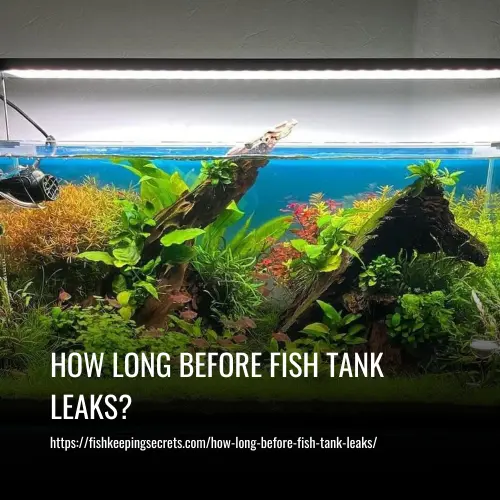To get more oxygen in your fish tank, you can add an air pump and airstone or increase surface agitation with a filter or bubbler. If you want your fish to thrive, it’s essential to provide a healthy, well-aerated environment in your tank.
Poor oxygen levels in your fish tank can lead to stressed or sick fish, low energy levels, and even death. Fortunately, there are a few simple steps you can take to improve oxygen levels in your aquarium. One of the most popular methods is to add an air pump and airstone to your tank.
This creates bubbles and breaks the surface tension of the water, increasing oxygen transfer. Alternatively, you can increase surface agitation by using a filter or bubbler. In this article, we will discuss some effective ways to get more oxygen in your fish tank, ensuring a thriving and healthy aquatic environment for your fish.

Common Oxygenation Methods
There are various methods to ensure that your fish tank has adequate levels of oxygen, but some of the most commonly used are:
1. Air Pumps And Air Stones:
Air pumps and air stones produce a stream of bubbles that increases water movement and oxygen exchange. They are usually available in different sizes, which vary in the amount of air they produce. Also, some air stones produce different sizes of bubbles, which can have different effects on water movement.
2. Powerheads And Water Circulation:
Powerheads are devices that improve water movement in the aquarium. They increase water circulation in the tank, which helps the water to absorb more oxygen from the air. This method is especially suitable for aquariums with a higher demand for oxygen, such as tanks with more fish, larger fish, or at higher temperatures.
3. Plants And Live Rock:
Plants in the tank play a role in oxygenating the aquarium as they absorb CO2 from the water and produce oxygen through photosynthesis. Live rock is also useful because it helps increase the surface area of the tank’s “biological filter,” which is where oxygen exchange takes place.
4. Protein Skimmers:
Protein skimmers work by creating an abundance of tiny bubbles that attract waste and debris in the tank. As the bubbles rise to the surface, they pull out the waste and debris, which helps to maintain a healthy level of oxygen in the tank.
It is important to choose the right oxygenation method for your aquarium to ensure that your fish stay healthy and happy. When selecting a method, consider factors such as tank size, number and variety of fish in the tank, and water temperature.
Understanding Oxygenation In Fish Tanks
Fishkeeping is a rewarding hobby but requires some level of responsibility. One of the essential factors to consider for healthy fish is proper oxygenation in the tank. In this section, we will explore the factors that affect oxygen levels in a fish tank, the importance of proper oxygenation for fish health, and how to measure oxygen levels in your tank.
Factors That Affect Oxygen Levels In A Fish Tank
Several factors can affect oxygen levels in your fish tank, and it’s essential to be aware of them to maintain a healthy environment for your fish.
- Temperature: The higher the water temperature, the lower the amount of oxygen it can hold. So, warmer tanks require more significant aeration.
- Aquatic plant life: While plants produce oxygen during the day, they consume it at night, leading to reduced oxygen levels. Overgrown plants can also block the water surface, reducing gas exchange.
- Biological waste: As fish produce waste, it breaks down into ammonia, leading to the growth of harmful bacteria and depleting oxygen levels.
- Type and size of fish: Different fish species have varying oxygen requirements. Overcrowding and overstocking can lead to an increase in bio-waste, which can further reduce oxygen levels.
Importance Of Proper Oxygenation For Fish Health
Maintaining adequate oxygen levels in your fish tank is crucial because it affects the overall health of your fish. Here are some reasons why:
- Oxygen is required for fish respiration, and inadequate levels can cause stress, suffocation and eventually, death.
- High oxygen levels will also encourage fish to display their vibrant colors, and fish growth will be optimal.
- Proper oxygenation means better water quality, leading to a healthier environment for your fish.
How To Measure Oxygen Levels In Your Tank
Measuring the oxygen levels in your tank is simple and can be done using the following methods:
- Test kits: Various water test kits are designed to measure oxygen levels and other water parameters. These test kits are easy to use, usually involving adding a few drops of test solution into your tank water and comparing the results to a color chart.
- Oxygen meter: An oxygen meter provides precise readings of oxygen levels in your tank but is a more expensive option.
I hope that this article has helped understand the importance of oxygenation in fish tanks, the factors that can affect oxygen levels, and how to measure oxygen levels in your tank. Remember, proper oxygenation enhances fish health and ensures a healthy ecosystem for your aquarium.
Additional Tips For Boosting Oxygenation In Your Fish Tank
Maintaining adequate oxygen levels is essential for fish health. Oxygen contributes to the overall wellbeing of your fish and aquatic plants. Therefore, it is necessary to ensure the proper level of oxygenation in your fish tank. Here are some additional tips to help you boost oxygenation in your fish tank:
1. Increasing Surface Agitation:
Surface agitation is an effective way to increase oxygen levels in your fish tank. When the water surface is agitated, it helps the oxygen from the atmosphere to mix with the tank water. This mixing process increases the amount of oxygen available for your fish.
You can use different equipment, such as air pumps, powerheads, and filters, to create surface agitation.
2. Adding An Oxygen Supplement:
An oxygen supplement can help increase oxygenation levels in your fish tank. There are different types of oxygen supplements available, such as oxygen drops, oxygen tablets, and liquid oxygen. You can choose the one that best suits your needs. Adding an oxygen supplement can also help during fish transport or during power outages, when there is a risk of oxygen depletion.
3. Adjusting Water Temperature:
Water temperature can affect the oxygen content in your fish tank. Warm water holds less oxygen than cold water. Therefore, it is essential to maintain an appropriate temperature range to ensure suitable oxygenation levels in your fish tank. Aerate the water when the temperature is high to increase the oxygen content.
4. Avoiding Overfeeding And Excess Waste:
Overfeeding and excess waste can harm the fish and affect the oxygen content in your fish tank. As the organic matter accumulates, it decomposes and consumes oxygen while releasing harmful gases like ammonia and nitrite. It is vital to feed your fish the appropriate amount and clean the tank regularly to prevent excess waste and maintain good water quality.
5. Monitoring Water Quality:
Water quality plays a crucial role in maintaining proper oxygen levels in your fish tank. Regularly monitor the water parameters like ph, ammonia, nitrite, and nitrate levels. Ensure that the parameters are within the appropriate range. High levels of waste and decomposition products like ammonia and nitrite can consume oxygen and affect the health of your fish.
Optimizing oxygen levels in your fish tank can ensure a rich and healthy aquatic environment. By following these additional tips for boosting oxygenation in your fish tank, you can help maintain the well-being of your aquatic pets.
Maintenance And Troubleshooting To Get More Oxygen In Your Fish Tank
Proper maintenance and troubleshooting can also help ensure optimal oxygenation in your fish tank. Here are some tips:
Regular Cleaning And Maintenance
Keeping a fish tank oxygenated is largely contingent on keeping it clean. Here are a few maintenance tips that will ensure your fish can breathe easy:
- Replace 25% of your tank water every two weeks.
- Clean your tank filter every month.
- Avoid overfeeding your fish.
Common Issues With Oxygenation
Even with regular maintenance, you might still run into oxygenation issues. Here are some common problems that can arise:
- Blockages in your tank filter
- Insufficient surface area for oxygen exchange
- Overcrowding of fish
Signs Of Low Oxygen Levels In Your Tank
It’s essential to be aware of the signs and symptoms of low oxygen so that you can take action quickly. Here are signs that your fish are not getting enough oxygen:
- Your fish are gasping for air at the surface of the water
- Your fish are taking rapid and shallow breaths
- The water has a murky appearance
Troubleshooting And Fixing Problems
Troubleshooting and fixing oxygenation problems requires a bit of detective work. Here are some ways to solve oxygenation issues:
- Try increasing surface agitation with an air pump or bubbler stone to increase oxygen exchange
- Ensure that no blockages are preventing the filter from properly working
- Consider reducing the number of fish if overcrowding is an issue
Remember, proper cleaning and maintenance are essential in preventing oxygenation issues. Still, having an understanding of common problems and symptoms is crucial if issues arise. By following these tips, you can ensure that your fish tank remains a healthy and hospitable environment for your aquatic friends.
FAQs
You can increase oxygen in your fish tank by adding air stones or diffusers to the tank. You can also increase the surface agitation of the water by using filters or water pumps.
You should aerate your fish tank at least once a day. If you have a heavily stocked tank or live plants, you may need to aerate more frequently. Keep the tank well-maintained, and perform regular water changes.
If your fish are gasping at the surface of the water or seem lethargic, it may be a sign that your tank doesn’t have enough oxygen. You can also purchase oxygen test kits to check the oxygen levels in your tank.
Too much oxygen can be harmful to fish. It can cause them to suffer from oxygen toxicity, which can lead to seizures or death. However, it is rare for a fish tank to have too much oxygen, as long as it is properly balanced.
Live plants can help oxygenate a fish tank during the day when they release oxygen through photosynthesis. However, at night, they consume oxygen like other organisms. Therefore, it is important to balance the number of plants in the tank with the fish’s oxygen needs.
Conclusion
From an aquarium hobbyist’s point of view, getting more oxygen in your fish tank is of utmost importance. It provides a healthy and safe environment for your aquatic pets to thrive in. Remember, too little oxygen in water can cause serious harm to your fishes and other inhabitants.
On the contrary, a well oxygenated tank promotes their overall well-being, making them happy and active. As we have explored in this post, there are several ways to increase the oxygen levels in your fish tank, such as adding an air pump, increasing water surface area, and incorporating live plants.
Happy fish keeping!



